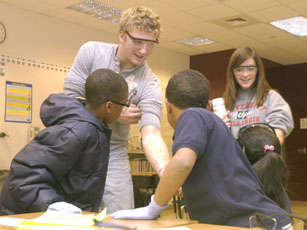University, elementary students bond over chemistry

Dan Rossi, freshman in LAS, shows iodine “tattooed” onto his arm to students in a third grade class at Stratton Elementary School in Champaign. Behind him Katie Coon, junior in LAS, holds a can of spray starch. The iodine was invisible until revealed by t Ben Cleary
December 9, 2005
University students are helping local third-graders get excited about chemistry through the Kids and Chemistry Outreach program. Participants in the program give an interactive lesson that teaches school children to see chemistry as a part of their daily lives.
“A good scientist can test their predictions in many ways,” said Katie Coon to a group of third-graders at Stratton Elementary in Champaign. Coon is a junior in LAS and participant in the Kids and Chemistry Outreach program.
University students in the program, during the fall semester, have visited about 100 classrooms in 43 area elementary schools within a 30-mile radius, said faculty co-director Lauren Denofrio, a teaching lab specialist at the University.
“It’s amazing, I think, what they come away with from the lesson; they really do absorb it,” Denofrio said.
The Kids and Chemistry third-grade program has about 250 participants. Each semester, the program’s participants learn lessons with a theme and take these lessons into the elementary schools, she added.
Get The Daily Illini in your inbox!
This fall semester’s lesson involves food chemistry. Four or five University students work with school children to determine whether common solutions like orange juice have complex or simple sugars, said undergraduate co-director Danielle Studer, senior in LAS. They make predictions and carry out experiments to see whether they were right, she said.
In an hour-long lesson, participants spend the first half-hour doing hands-on experiments with the school children and the last half-hour doing a larger scale demonstration for the class.
In the hands-on part of the lesson, the participants show that common things found in the household can safely reveal principles of chemistry, Studer said.
“We don’t only want to get students interested in chemistry, but we want them to realize that it’s really vital for everyday life,” she said.
The demonstrations this semester include a clock that is powered by Gatorade and iodine tattoos that become visible with spray starch. The tattoos come off with a bit of ascorbic acid, or vitamin C, Studer said.
“They really enjoyed it because it’s hands-on, so it’s not something they just watch – they actually get to participate,” said Brooke Billings, a teacher at Thomasboro Grade School in Thomasboro, Ill.
The third grade students, in the weeks following the activity, relate back to the lessons they were taught, Billings said. They asked about whether their food was made of simple or complex sugars, she said.
As part of the lesson, University students talk about their future career plans with the school children.
“It gives them an idea of what chemistry is,” Billings said. “It helps them understand that chemistry can be used in many areas.”
Studer said that her last four years of work with the program has been worth it because of the impact the program has had on the school children.
“The kids were really excited to learn chemistry, and they were telling us they wanted to go to U of I to become scientists like us,” Studer said.
The Kids and Chemistry program was started by Angela Cannon, a former faculty advisor for the University of Illinois American Chemical Society-Student Affiliates chapter. A few years ago, the program had fewer than 100 participants and visited 12 to 15 area schools each semester, Studer said
To meet the growing interest of University students, the Kids and Chemistry Outreach program has expanded beyond the third-grade program, Denofrio said. They have a Family Nights program and Don Moyer Boys and Girls Club program with about 40 participants in each program, she said.
University students participate in the program for honor’s credit for a parent chemistry course, said Jesse Miller, faculty co-director of the program and a teaching lab specialist at the University. Many of the honors students return as volunteers because they enjoyed their experience, he said.
Some University students participate as program staff by registering for Chemistry 199K, a special course for the program. Members of the staff have responsibilities that range from designing new lessons to setting up interactive activities on the Internet that the school children can show their parents, Denofrio said.
Last spring, the program received a grant from the provost’s Initiative on Teaching Advancement, which is used to purchase chemistry supplies. The program receives workspace and staff support from the Department of Chemistry and School of Chemical Sciences.






